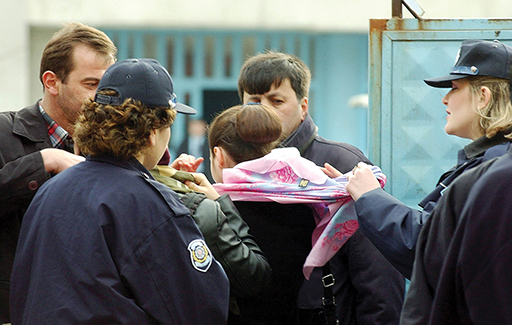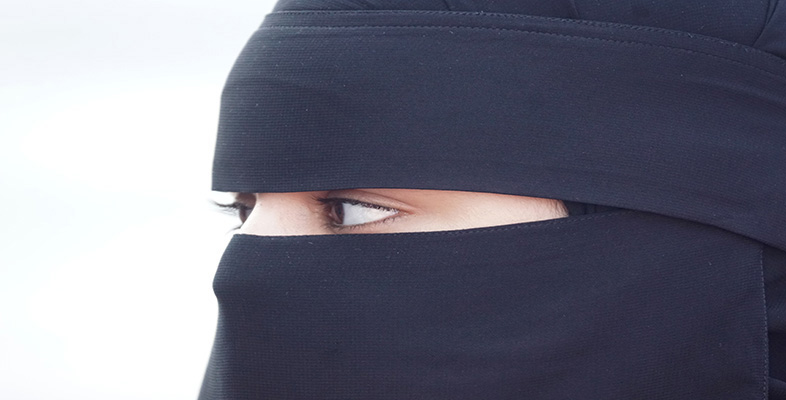2 ‘Do they make you veil?’
After considering different styles of veiling and the terminology used to describe them, I would now like to move on to consider factors that influence why women do or do not wear veils or adopt particular veiling styles and practices. To what extent is women’s rejection or adoption of the Islamic veil (in whatever form) constrained by rules and expectations imposed on them by their families, local religious authorities, communities or governments? How much room is left for individual agency, choice and creative expression?
In mainstream media and political debates in Europe and North America, the hijab, burqa and niqab in particular have frequently been associated with the oppression of women (see, for instance, Sinclair, 2012). It is often assumed that male family members force women to veil themselves. (See, for example, Shaheed’s reference to the question ‘Do they make you veil?’ at the beginning of Reading 2.) The idea that Muslim women need to be rescued and liberated from ‘Islamic male tyranny’ has had ‘tremendous emotional appeal and longevity’ (Morey and Yaqin, 2011, p. 10). However, perhaps the issues are not as clear-cut. As Lewis points out:
In all these developments, women’s agency has been central as they struggle to deal with the myriad ways in which the figure of woman becomes symbolic for all sides of the political debate. Yet the veil is often read by the West as evidence of the very denial of women’s agency, or is over-inflated into the most important feminist struggle. But, in fact, the requirement of the veil is often least of their problems.
The British researcher Sophie Gilliat-Ray (2011) argues that a disproportionate amount of public attention has been paid to the outer appearance of Muslim women, when other issues that are of much greater concern to them are often neglected, such as access to adequate housing, education or appropriate healthcare, or help with caring responsibilities for young children and older people.
In some countries (such as Iran or Saudi Arabia) women have been expected or even forced to veil themselves, while in others (such as France, Belgium or Turkey) governments, institutions or employers have imposed bans on hijabs, burqas or niqabs. In addition to concerns regarding either the separation or the union of state and religious authorities, both veiling bans and the legal imposition of veils have often at least partly been justified on the ground that they protect and liberate women. However, they have also been criticised for limiting women’s choices and their freedom of expression. In recent years, an increasing number of young women have voluntarily adopted the veil, and many Muslim women have actively resisted the introduction and enforcement of regulations banning veils. Figure 3 shows a female university student in Turkey amid male and female police officers who are tearing off her hijab against her will as they are enforcing a hijab ban at Turkish universities. This photograph was taken in 2001, and strict regulations banning hijabs at universities in Turkey have since been considerably eased in response to public protests.

The understanding of the hijab as a symbol of resistance and solidarity can be traced back to the 1970s, when the hijab became increasingly regarded as ‘a symbol of public modesty that reaffirms Islamic identity and morality and rejects Western materialism, commercialism, and values’ (‘Hijab’ in Esposito, 2003). In her book A Quiet Revolution (2011) Leila Ahmed, an Egyptian American scholar of Islam and Islamic feminism, examines changing dress codes among Muslim women across the globe, with particular focus on Egypt and the USA. She argues that Egypt was the first ‘country in which the new hijab and Islamic dress had begun to appear’ (Ahmed, 2011, p. 118). It was initially adopted in the 1970s by a relatively small group of female university students who associated themselves with the Muslim Brotherhood (which you encountered in Book 1, Chapter 4), but has since spread across the world. Ahmed’s use of the term ‘new hijab’ refers to the fact that the resurgence of the hijab in Egypt in the 1970s was preceded by a period of time when ‘being unveiled and bareheaded had become the norm in the cities of Egypt, as well as in those of other Muslim-majority societies’ (Ahmed, 2011, p. 10). She also maintains that the ‘new hijab’ had relatively little resemblance to traditional Egyptian styles of veiling in terms of its style, fabric and colours (Ahmed, 2011, p. 83). She argues that ‘These garments were essentially standardized and were typically in sober solid colours, such as blue, brown and beige. […] This standardization in material and color had the effect of erasing social and economic differences between wearers’ (Ahmed, 2011, p. 83).
In this context, the hijab was used not only as a symbol of Muslim women’s public assertion of their religious identity but also of their active participation in the fight for social justice and against wealthy elites, ‘western’ imperialism and secularisation. Although in the 1970s it was a relatively small minority movement that understood the hijab in this way, in recent decades across the globe an increasing number of young Muslim women have adopted the hijab (in different styles, colours and materials) for similar reasons. For example, drawing on two decades of research on US American Muslim communities, Yvonne Haddad, a scholar studying the history of Islam and Christian–Muslim relations, observes that in the aftermath of 9/11 (the attacks on the World Trade Center and the Pentagon in September 2001) ‘an increasing number of adolescents and young adults (daughters of immigrant Muslims) are assuming a public Islamic identity by wearing the hijab […] despite the fact that their mothers have never dressed Islamically’ (2007, pp. 253–4). She argues that many women have donned the hijab in response to and resistance against ‘Islamophobia that took hold as a consequence of the propaganda for the war on terrorism’ (Haddad, 2007, p. 253) and as a symbol of pride and solidarity with Muslims that have been the target of hostility, abuse or discrimination (see also Chrisafis, 2001). It is, however, important to bear in mind that there are a wide range of different, complex factors involved in why women don the hijab or adopt a particular style of veiling, and in how much choice they have in the matter.
